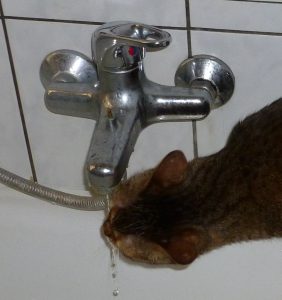Causes

Polly was only 8 years old when she was diagnosed as being hyperthyroid
Hyperthyroidism means your cat has over-active thyroid glands: they’re producing too much of the thyroid hormones T3 and T4.
This happens when your cat’s thyroid glands have become enlarged. Both glands are usually affected, although one may be more enlarged.
Hyperthyroidism is the most common hormone-related condition in older cats; the vast majority of cats diagnosed with hyperthyroidism will be over 10 years old. Very rarely, young cats are also affected.
You’ll be pleased to know that almost all hyperthyroid cats can be treated very successfully. Most will make a complete recovery and can be considered cured. However, there are different treatments, and some have significant advantages over others. The fastest, most reliable way to treat feline hyperthyroidism is with radio-iodine.
Where are your cat’s thyroid glands?
Your cat has a pair of thyroid glands, on either side of his or her throat, but thyroid tissue also sometimes occurs in the chest.
What do your cat’s thyroid glands do?
The thyroid glands produce hormones called thyroxine and triiodothyronine, which are carried around the body in the bloodstream. Triiodothyronine regulates many physiological processes, including your cat’s metabolic rate.
What happens with an overactive thyroid?
The more thyroid hormone your cat produces, the more their metabolic rate will accelerate. And the faster it is, the more calories your cat will burn. That’s why the typical symptoms include weight loss and restlessness. Hyperthyroidism can also cause damage to the heart, brain, eyes, kidneys and other organs. That’s why it’s so important to treat this condition: it affects almost the whole body.

Some cats drink more than usual when hyperthyroid
Did your vet mention a tumour?
If you’re worried your cat might have cancer, it’s very unlikely. An enlarged thyroid gland does usually occur because your cat has a lump – so you might have heard your vet say the word ‘tumour’. However, the vast majority of these tumours are benign (non-cancerous). Fewer than 2% of cats with hyperthyroidism have thyroid cancer. However, if your cat’s tumour is cancerous, it will be more difficult to treat.
How is hyperthyroidism diagnosed?
You may pick up on one or more symptoms yourself, like a deterioration in your cat’s coat or an excessive thirst. When you discuss this with your vet, they may suspect hyperthyroidism and suggest a blood test to measure your cat’s thyroxine levels. They will also want to weigh your cat and assess its ‘body condition score’, or BCS, which will tell you whether your cat is underweight for its size, gender and age.


